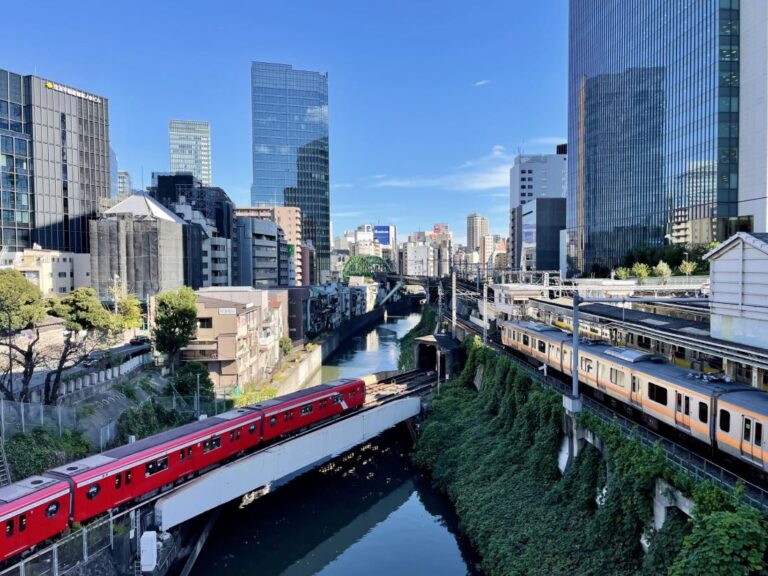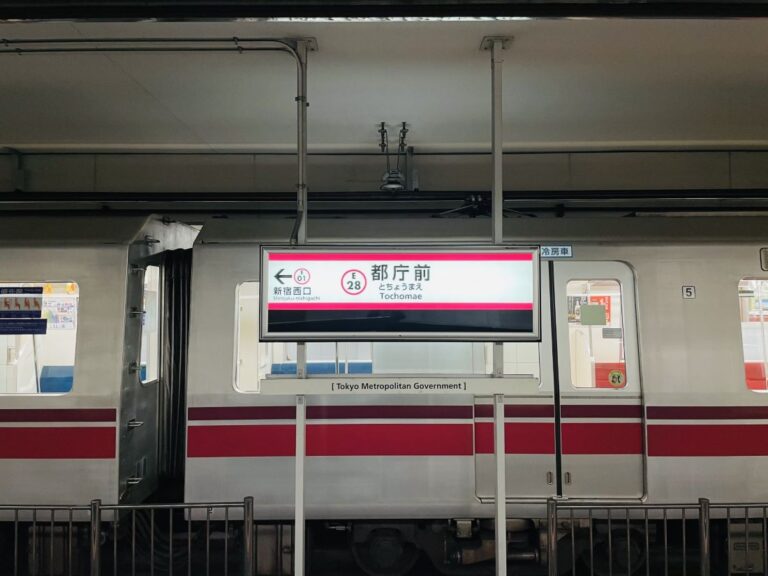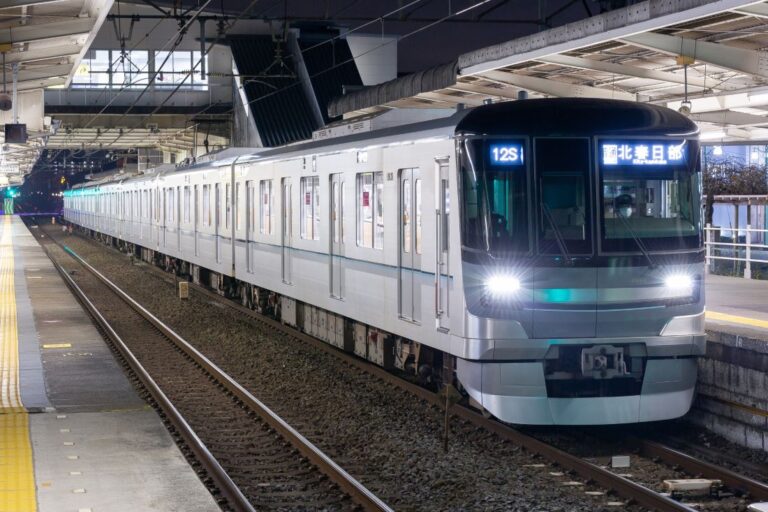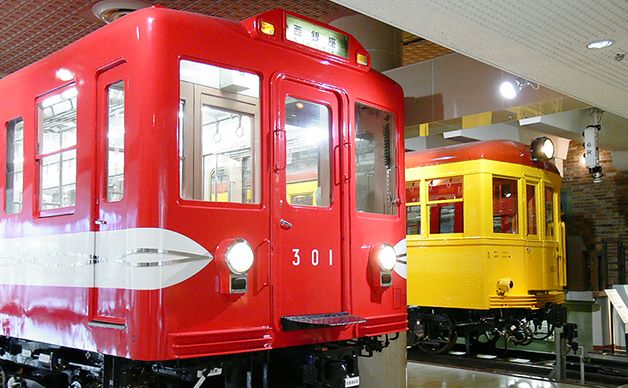The Yūrakuchō Line is one of the many lines operated by the Tokyo Metro, and it has been serving the city since 1974. The line is known for its distinctive gold color, which can be seen on the trains and in the stations, while it is given the Y abbreviation on Metro signs.
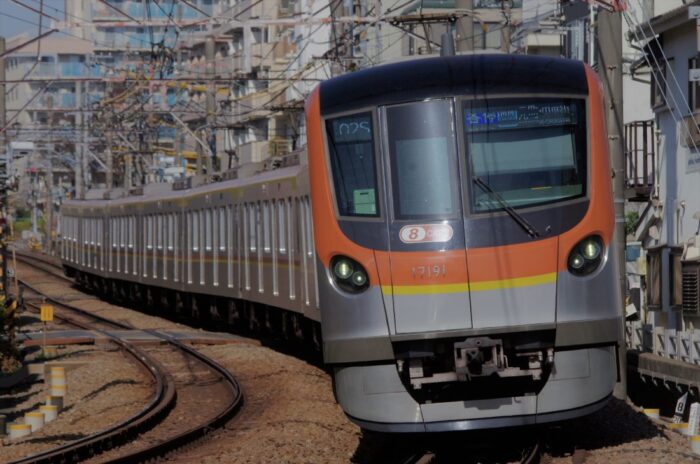
The Yūrakuchō Line is an important transportation route that runs from Shin-Kiba Station in the eastern part of the city to Wakōshi Station in the northwestern suburbs, passing through some of Tokyo’s major business and commercial districts along the way.
It runs on rubber tires instead of traditional steel wheels o you will notice a smoother and quieter ride, which is especially appreciated by commuters during rush hour.

The line also has some of the deepest stations in Tokyo, with some platforms more than 40 meters underground.
Yūrakuchō Line Map

Route

The Yūrakuchō Line is a subway line operated by Tokyo Metro. It runs from Wakōshi Station in Saitama Prefecture to Shin-Kiba Station in Tokyo. The line is 23.5 kilometers long and has 20 stations. The line is colored gold on subway maps and station signs.
The line starts at Wakōshi Station in Wakō, Saitama Prefecture, and runs southeast towards Tokyo. It passes through the cities of Kawaguchi, Warabi, and Asaka before entering Tokyo. In Tokyo, the line passes through the wards of Itabashi, Toshima, Shinjuku, Chiyoda, and Chūō before terminating at Shin-Kiba Station in Kōtō.
The Yūrakuchō Line is an important subway line in Tokyo, connecting many important areas of the city. It intersects with many other subway and train lines, making it easy to transfer to other lines. Some of the major stations on the line include Ikebukuro, Shinjuku, and Tokyo Station. Ikebukuro and Shinjuku are major commercial and entertainment districts, while Tokyo Station is a major transportation hub.
The Yūrakuchō Line is known for its distinctive gold-colored trains. The trains have a unique design, with a curved front and a gold stripe running along the sides. The trains are also known for their quiet operation, thanks to their rubber tires. The line is operated by Tokyo Metro, which is known for its efficient and reliable service.
| Station No. | Station Name | Connecting Lines |
|---|---|---|
| Y01 | Wakoshi | Fukutoshin Line, Tobu Tojo Line |
| Y02 | Chikatetsu-narimasu | Fukutoshin Line, Tobu Tojo Line (Narimasu) |
| Y03 | Chikatetsu-akatsuka | Fukutoshin Line, Tobu Tojo Line (Shimo-Akatsuka) |
| Y04 | Heiwadai | Fukutoshin Line |
| Y05 | Hikawadai | Fukutoshin Line |
| Y06 | Kotake-mukaihara | Fukutoshin Line, Seibu Yūrakuchō Line |
| Y07 | Senkawa | Fukutoshin Line |
| Y08 | Kanamecho | Fukutoshin Line |
| Y09 | Ikebukuro | Marunouchi Line, Fukutoshin Line, Yamanote Line, Saikyō Line, Shōnan-Shinjuku Line, Tobu Tojo Line, Seibu Ikebukuro Line |
| Y10 | Higashi-ikebukuro | Tokyo Sakura Tram (Toden Arakawa Line, Higashi-ikebukuro-yonchome) |
| Y11 | Gokokuji | |
| Y12 | Edogawabashi | |
| Y13 | Iidabashi | Tozai Line, Namboku Line, Ōedo Line, Chūō-Sōbu Line |
| Y14 | Ichigaya | Namboku Line, Shinjuku Line, Chūō-Sōbu Line |
| Y15 | Kojimachi | |
| Y16 | Nagatacho | Hanzōmon Line, Namboku Line, Ginza Line (at Akasaka-mitsuke), Marunouchi Line (at Akasaka-mitsuke) |
| Y17 | Sakuradamon | |
| Y18 | Yurakucho | Yamanote Line, Keihin-Tōhoku Line, Hibiya Line (Hibiya), Chiyoda Line (Hibiya), Mita Line (Hibiya) |
| Y19 | Ginza-itchome | Ginza Line (Ginza), Marunouchi Line (Ginza), Hibiya Line (Ginza) |
| Y20 | Shintomicho | Hibiya Line (Tsukiji) |
| Y21 | Tsukishima | Toei Oedo Line |
| Y22 | Toyosu | Yurikamome |
| Y23 | Tatsumi | |
| Y24 | Shin-kiba | Keiyo Line, Rinkai Line |
Stations

The Yūrakuchō Line runs from Wakōshi Station in Saitama Prefecture to Shin-Kiba Station in Kōtō, Tokyo. Along the way, it passes through 19 stations, each with its own unique character and attractions. Some of the most notable stations on the Yūrakuchō Line include:
Ginza Station
Ginza Station is in the heart of Tokyo’s upscale Ginza shopping district. The station is connected to major department stores and shopping centers, including the famous Mitsukoshi and Matsuya department stores. Visitors to Ginza Station can also enjoy a stroll down the famous Chuo-dori street, which is lined with luxury boutiques and flagship stores.
Ikebukuro Station

Ikebukuro Station is one of the busiest stations on the Yūrakuchō Line, serving as a major transportation hub for the surrounding area. The station is connected to other train and subway lines, including the JR Yamanote Line and the Marunouchi Line. Visitors to Ikebukuro Station can enjoy shopping at the nearby Sunshine City complex, which features shops, restaurants, and entertainment venues.
Shin-Kiba Station
Shin-Kiba Station is in the Kōtō ward of Tokyo and is known for its proximity to the Tokyo Disney Resort. Visitors to Shin-Kiba Station can easily access the resort via the JR Keiyo Line or the Disney Resort Line monorail. The station is also connected to the Tokyo Metro Tozai Line, making it a convenient destination for travelers heading to other parts of Tokyo.
Attractions on the Yūrakuchō Line
Here’s a rundown of the attractions you can access from the line
| Station Name | Nearby Attractions |
|---|---|
| Wakoshi | Chikatetsu Wakoshi Park, Tobu Tojo Line |
| Chikatetsu-Akatsuka | |
| Heiwadai | Heiwadai Park, Heiwadai-eki-mae Park |
| Hikawadai | Hikawadai Park, Seibu Ikebukuro Line |
| Kotake-Mukaihara | Kotake-Mukaihara Park |
| Senkawa | Senkawa Park, Toshima Ecomuse Town |
| Kanamecho | |
| Ikebukuro Station | Sunshine City, Ikebukuro West Gate Park, J-World Tokyo |
| Higashi-Ikebukuro | Bunka Gakuen Costume Museum |
| Gokokuji | Gokokuji Temple, Tokyo Medical and Dental University |
| Edogawabashi | Edogawa Park, Tokyo Dome City |
| Iidabashi | Kagurazaka, Tokyo Dome City, Japan-China Friendship Garden |
| Ichigaya | Ministry of Defense, Yasukuni Shrine, Chidorigafuchi Park |
| Kojimachi | Hanzomon Gate of the Imperial Palace, Kioi Hall |
| Nagatacho | National Diet Building, Hie Shrine, Akasaka Palace |
| Sakuradamon | Sakurada Gate, Imperial Palace East Gardens |
| Yurakucho | Ginza, Hibiya Park, Tokyo International Forum, Yurakucho Area |
| Ginza-itchome | Ginza, Kabuki-za Theatre |
| Shintomicho | Tsukiji Honganji Temple |
| Tsukishima | Tsukuda Park, Tsukishima Monja Street |
| Toyosu | Toyosu Lalaport, Gas Science Museum, Toyosu Park |
| Tatsumi | Tatsumi International Swimming Center, Tatsumi-no-Mori Green Park |
| Shin-Kiba | Ageha, Studio Coast, Yumenoshima Park, Yumenoshima Tropical Greenhouse Dome |
Myths Of The Yūrakuchō Line
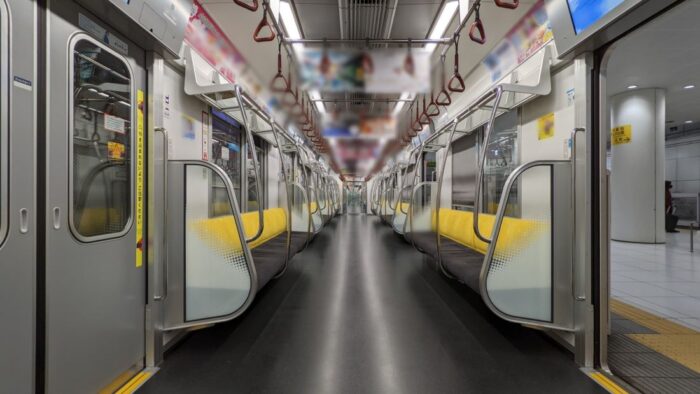
Apart from these media appearances, the Yūrakuchō Line has also been the subject of urban legends in Japan. One such legend involves a ghost train that supposedly runs on the Yūrakuchō Line late at night, with passengers who are all ghosts or spirits.
Another legend claims that the Yūrakuchō Line is cursed, and that anyone who rides it on a certain day or time will suffer misfortune or even death. Despite these rumors and legends, the Yūrakuchō Line remains a popular mode of transportation for commuters and visitors to Tokyo
In Popular Culture
The Yūrakuchō Line has been featured in popular culture media in Japan. Here are some notable examples:
- The 2004 Japanese film “Train Man” (Densha Otoko) features the Yūrakuchō Line as the main setting for scenes. The film tells the story of a shy otaku who falls in love with a woman he met on the train and seeks advice from an online forum.
- The Yūrakuchō Line is also featured in the popular manga and anime series “Detective Conan” (Case Closed). In one episode, the main character, a high school detective named Shinichi Kudo (also known as Conan Edogawa), solves a murder case that takes place on the Yūrakuchō Line.
- The Yūrakuchō Line also appears in the 2014 video game “Persona Q: Shadow of the Labyrinth” as one of the dungeons that the player characters can explore.
History
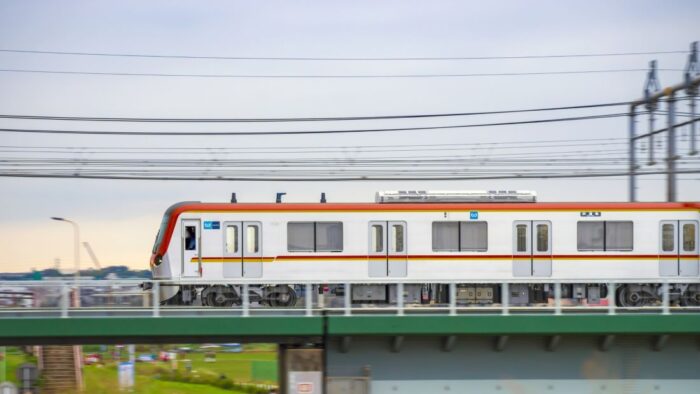
The Yūrakuchō Line was first opened in 1974 and was the first subway line to be built in Tokyo in 13 years. The line is operated by Tokyo Metro and is part of the Tokyo subway system and is named after Yūrakuchō, a district in Chiyoda ward famous for its trackside izakayas, where the line terminates.
Originally, the line only had six stations, but it has since been extended to include 19 stations. The line runs from Shin-Kiba Station in Kōtō ward to Wakōshi Station in Saitama prefecture. The line is 23.2 km long and serves some of Tokyo’s most popular tourist destinations, including Tokyo Disneyland, Tokyo Tower, and Ginza.
The line was built to alleviate congestion on the Ginza Line, which was Tokyo’s first subway line. The Ginza Line was built in 1927 and was the only subway line in Tokyo until 1954, when the Marunouchi Line was opened. By the 1960s, the Ginza Line was overcrowded and needed to be expanded. The Yūrakuchō Line was built to provide an alternative route for commuters traveling between Shinjuku and Shibuya.
Rolling Stock
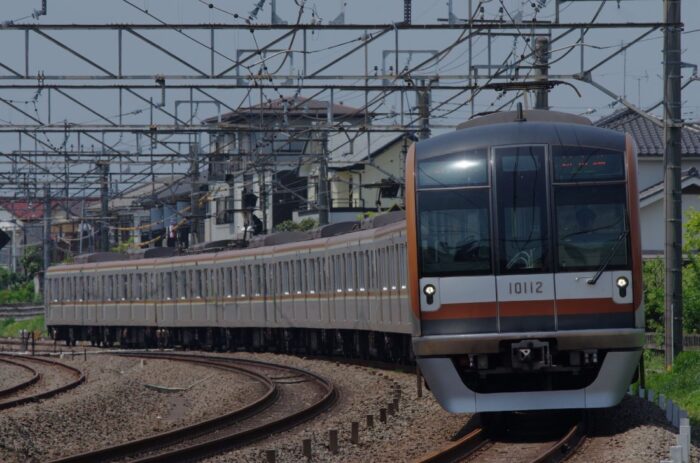
The Yūrakuchō Line operates with two types of rolling stock: the Tokyo Metro 10000 series and the Tokyo Metro 17000 series. Let’s take a closer look at each of these trains.
The Tokyo Metro 10000 series began operation in September 2006 and is used on both the Yūrakuchō and Fukutoshin lines. These 20-meter-long trains consist of 10 cars, with four doors per side and longitudinal seating.
They are equipped with LED displays and automated announcements, making it easy for passengers to know which station is coming up next. The Tokyo Metro 17000 series, on the other hand, began operation in February 2021 and is currently only used on the Yūrakuchō Line.
These trains are also 20 meters long and consist of 10 cars, but they have a different seating arrangement than the 10000 series. They have a mix of longitudinal and lateral seating, with more priority seats for passengers with disabilities.
Both the 10000 and 17000 series trains are equipped with air conditioning and are designed to be energy-efficient. They are also equipped with safety features such as automatic train control and anti-slip brakes.
Future Developments
future developments are planned to improve the line and make commuting even easier. One of the most significant developments is the extension of the line to Haneda Airport. This project is expected to be completed by 2027 and will provide direct access to the airport from central Tokyo.
The extension will also include the construction of a new station, Shinagawa Shin-Eki, which will serve as an interchange with the Keikyu Main Line. Another development that is currently underway is the installation of platform doors at all stations on the line.
This project is expected to be completed by 2023 and will improve safety and efficiency by preventing accidents and reducing delays caused by overcrowding. In addition to these major developments, the Yūrakuchō Line is also exploring the possibility of introducing express services during peak hours.
This would allow commuters to reach their destinations faster and reduce overcrowding on trains. Overall, these developments demonstrate the commitment of the Yūrakuchō Line to providing a safe, efficient, and convenient commuting experience for its riders. As the line continues to evolve, it will remain an essential part of Tokyo’s transportation network.
Incidents and Accidents on Yūrakuchō Line
Unfortunately, like any other transportation system, incidents and accidents can occur. Here are some notable incidents and accidents that have occurred on the Yūrakuchō Line. In 2005, a train on the Yūrakuchō Line derailed near Edogawabashi Station, injuring five passengers.
The cause of the derailment was determined to be a broken rail. As a result, the Tokyo Metropolitan Government and Tokyo Metro conducted a comprehensive inspection of all tracks on the Yūrakuchō Line. In 2018, a passenger on the Yūrakuchō Line was hit by a train at Kotake Mukaihara Station. The passenger was standing too close to the edge of the platform and fell onto the tracks.
Fortunately, the passenger survived the incident with only minor injuries. This incident serves as a reminder to always be aware of your surroundings when using public transportation. In 2020, a train on the Yūrakuchō Line collided with a maintenance vehicle on the tracks near Wakōshi Station.
The train driver and two maintenance workers were injured in the accident. The cause of the accident was determined to be human error, as the maintenance vehicle had not properly cleared the tracks.
incidents and accidents on the Yūrakuchō Line are relatively rare, and Tokyo Metro has implemented safety measures to prevent them from occurring.

